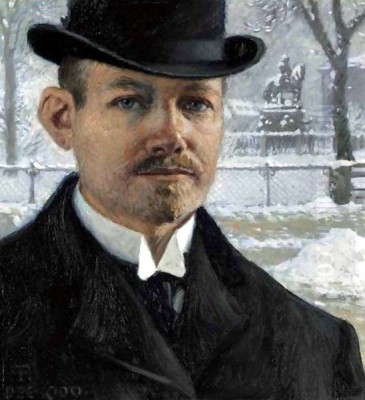
Paul Gustave Fischer stands as a significant figure in Danish art history, primarily celebrated for his evocative depictions of urban life, particularly the bustling streets and intimate moments of his native Copenhagen. Born on July 22, 1860, and passing away on January 5, 1934, Fischer's life spanned a period of considerable artistic change in Europe. While he may not have garnered widespread critical acclaim during his peak years, his work enjoyed immense popularity and commercial success, leaving behind a cherished visual record of Denmark at the turn of the 20th century. His ability to capture fleeting moments, the play of light, and the atmosphere of the city ensures his enduring appeal.
Early Life and Artistic Formation
Paul Gustave Fischer was born into a middle-class family in Copenhagen. His family was of Polish-Jewish descent, representing the fourth generation of Fischers residing in Denmark. This heritage placed him within a specific cultural context in the Danish capital. His father, Philip August Fischer, initially pursued a career as a painter himself before finding greater success in the business world as a manufacturer of paints and varnishes. This artistic background in the family undoubtedly provided an early exposure and perhaps encouragement for young Paul's burgeoning interest in art.
His formal artistic education began in 1876 when he enrolled at the prestigious Royal Danish Academy of Fine Arts in Copenhagen. However, his time at the Academy was notably brief. He spent only about two years studying there before deciding to leave, suggesting perhaps a dissatisfaction with the academic curriculum or a desire to forge his own path. Despite this short stint in formal training, his father's initial guidance and his own innate talent propelled him forward. The Academy, at that time, was a central institution in Danish art, fostering talents like P.S. Krøyer and Vilhelm Hammershøi, though Fischer's trajectory would differ significantly from these contemporaries.
Launching a Career: Illustration and Early Style
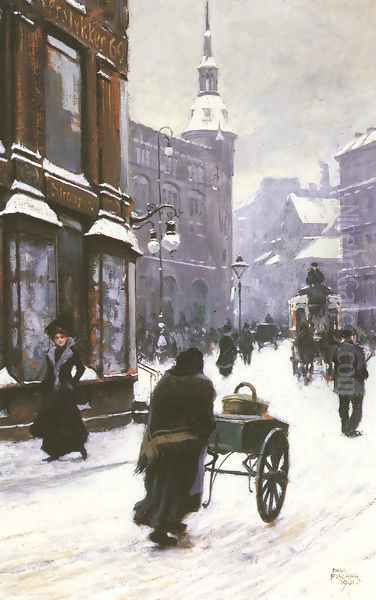
Fischer's professional artistic career effectively began not with grand canvases, but with illustrations. Around 1882, he found early success by selling his drawings to the popular Danish magazine Ude og Hjemme (Out and Home). This work provided him with both income and visibility. It honed his skills in observation and narrative composition, abilities that would serve him well in his later paintings. This path, starting with illustration before focusing on painting, was not uncommon for artists of the period.
His early paintings primarily focused on the subject matter that would become his hallmark: city life. However, the style of these initial works often reflected a more somber mood. They frequently depicted Copenhagen under overcast skies or during the winter months, characterized by a relatively subdued palette and a focus on the grey, atmospheric quality of the Nordic city. These early pieces show his developing interest in capturing the everyday reality of the urban environment, even if the brighter aspects were yet to fully emerge in his work.
The Parisian Transformation
A pivotal period in Fischer's artistic development occurred between 1891 and 1895 when he spent considerable time in Paris. The French capital was then the undisputed center of the art world, buzzing with the energy of Impressionism, Post-Impressionism, and various realist movements. Exposure to this vibrant scene had a profound and lasting impact on Fischer's art. He encountered the works of contemporary French artists who were revolutionizing the depiction of modern life.
Specifically, he was drawn to the work of French Realists and illustrators known for their depictions of Parisian life, such as Théophile Steinlen and, most notably, the Post-Impressionist master Henri de Toulouse-Lautrec. The influence of these artists, particularly their dynamic compositions, their focus on contemporary urban subjects, and their bolder use of color and line, is evident in the subsequent evolution of Fischer's style. His time in Paris encouraged him to embrace a much richer, brighter, and more luminous palette. The greys and muted tones of his earlier work began to give way to sunnier hues and a more vibrant depiction of light.
Master of the Urban Scene: Capturing Copenhagen
Following his transformative experience in Paris, Fischer solidified his reputation as the preeminent painter of Copenhagen. He developed an exceptional ability to capture the unique atmosphere and energy of the Danish capital's streets, squares, and public spaces. His paintings from the 1890s through the first decade of the 20th century, considered his peak period, are filled with lively depictions of city dwellers going about their daily lives – strolling along boulevards, gathering in marketplaces, riding trams, or enjoying moments of leisure.
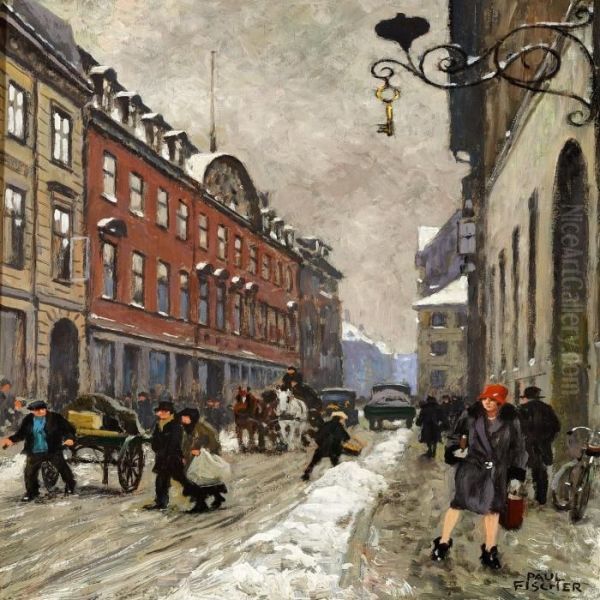
Fischer possessed a keen eye for detail, capturing the specific architecture, fashions, and social interactions of the era. He was particularly adept at rendering the effects of light, whether it be the crisp sunlight on a summer day, the reflections on wet pavement after rain, or the warm glow of gas lamps in the evening. Works like A Street Scene in Copenhagen exemplify his skill in creating dynamic compositions bustling with activity, yet maintaining a sense of intimacy and immediacy. He can be compared to French painters of urban life like Jean Béraud, though Fischer retained a distinctly Scandinavian sensibility. His work provides an invaluable visual document of Copenhagen during a period of significant modernization.
Expanding Horizons: Travel and Subjects
While Copenhagen remained his primary muse, Fischer's artistic interests extended beyond the Danish capital. He traveled extensively throughout his career, drawing inspiration from various locations across Europe. His journeys took him to other parts of Scandinavia, as well as to Italy and Germany. These travels resulted in numerous paintings depicting the landscapes, cityscapes, and local life of the places he visited.
His Italian scenes often capture the bright Mediterranean light and classical architecture, contrasting with the softer, cooler light of his Nordic paintings. Similarly, his depictions of German cities or Scandinavian landscapes showcase his versatility and his ability to adapt his style to different environments and atmospheres. This broader geographical scope added variety to his oeuvre and demonstrated his engagement with different European artistic traditions and settings, though his fame remained most closely tied to his Danish scenes.
Scandinavian Connections and Artistic Milieu
Fischer's development occurred within the context of a flourishing Scandinavian art scene. He was influenced by, and connected with, contemporary artists from neighboring countries. Notably, the influence of the Swedish painter Carl Larsson is often cited. Larsson was renowned for his idyllic watercolor depictions of domestic life, characterized by bright colors and strong outlines. Fischer's interest in sunnier palettes and potentially his depictions of intimate family life, such as Formiddag i hjemmet på Sofievegaard (Morning at Home at Sofievegaard), may show an affinity with Larsson's popular style.
Furthermore, Fischer's frequent depiction of bathing scenes, often featuring nude figures by the seaside, aligns with a popular theme among Scandinavian artists of the time. Artists associated with the Skagen Painters group in Denmark, such as Michael Ancher and Anna Ancher, were masters at capturing the unique light of the coast and scenes of local life, including leisure activities. While Fischer wasn't part of the core Skagen group, his interest in light-filled, plein air scenes, particularly those involving water and sunlight, resonates with the broader trends in Danish and Scandinavian painting, which often blended Realism with Impressionistic concerns for light and atmosphere. His work offers a contrast to the more psychologically intense art of contemporaries like Norway's Edvard Munch.
Themes and Motifs: Bathing Nudes and Daily Life
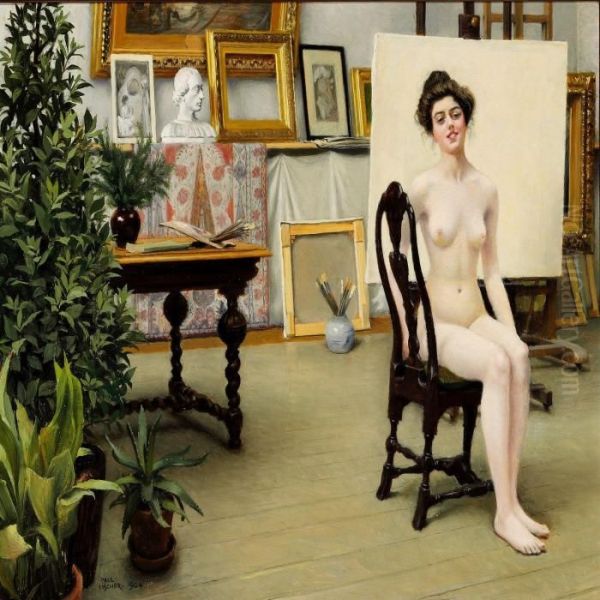
Beyond the bustling city streets, certain themes recur in Fischer's work. One prominent motif is the depiction of bathers, particularly women, often nude or semi-nude, enjoying the seaside. These scenes, typically set on sunny beaches, allowed Fischer to explore the play of light on skin and water, combining the academic tradition of figure painting with the modern interest in leisure and plein air settings. This subject matter, popular among Scandinavian artists, reflected a growing appreciation for nature and outdoor life. Fischer handled these scenes with a characteristic brightness and vitality.
His interest in posters, likely stimulated by his exposure to Toulouse-Lautrec and Steinlen in Paris, also manifested in his work, including illustrations for children's books. This demonstrates his engagement with graphic arts alongside his painting practice. Furthermore, intimate interior scenes, like the aforementioned Formiddag i hjemmet på Sofievegaard, reveal a quieter, more personal side of his art, focusing on domestic tranquility and family life. The painting Red Umbrella is another well-known example showcasing his ability to use a striking color accent within a carefully composed urban or social scene, drawing the viewer's eye and adding a touch of elegance or narrative intrigue.
Commercial Success vs. Critical Reception
A defining aspect of Fischer's career was the disparity between his popular appeal and his reception by contemporary art critics. Throughout his most productive years, Fischer's paintings were highly sought after by collectors and the public. He was commercially very successful, able to sell his works readily, which provided him with a comfortable living. He actively participated in exhibitions, ensuring his work was visible to a broad audience. His depictions of familiar Copenhagen scenes and pleasant, light-filled subjects resonated strongly with bourgeois tastes.
However, art critics of the time often overlooked him or regarded his work as perhaps too pleasing, too commercially oriented, and lacking the perceived depth or innovative edge of more avant-garde movements. He faced competition from other established Danish artists, such as Laurits Tuxen, who was known for his royal portraits and large-scale historical paintings. Despite this lack of critical validation during his lifetime, Fischer maintained a dominant presence in the Danish art market through his consistent output and popular subject matter. His connection with younger Danish Naturalists early in his career also helped establish his reputation within certain artistic circles.
The Royal Commission: A Mark of Recognition
A significant moment of official recognition came later in Fischer's career. In 1905, a pivotal event occurred in Scandinavian history: the dissolution of the union between Sweden and Norway, leading to Norway regaining its full sovereignty. To commemorate this historic occasion, King Haakon VII of Norway commissioned Paul Gustave Fischer to create a painting depicting the event.
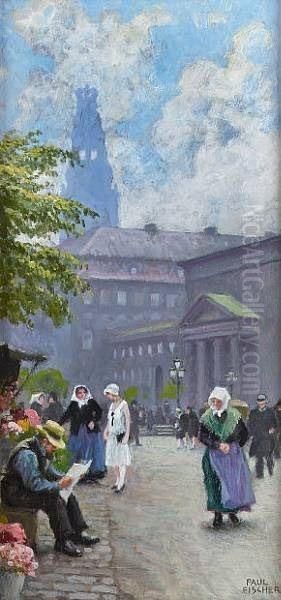
This prestigious commission was a major acknowledgment of Fischer's standing as an artist capable of handling important historical subjects. It brought him considerable fame and solidified his reputation, not just as a painter of charming city scenes, but as an artist recognized at the highest levels. The choice of Fischer, a Danish artist, for this Norwegian national subject might also reflect the interconnectedness of the Scandinavian art worlds and possibly the influence of supportive figures like Carl Larsson. This commission marked a high point in his public career.
Personal Life and Artistic Legacy
In 1886, Paul Gustave Fischer married Dagny Grønneberg. The couple had a daughter, Harriet Fischer, who followed in her father's footsteps and also became a painter. This familial connection to art, stretching back to his own father, underscores the environment in which Fischer lived and worked. His family life likely provided subjects and inspiration for some of his more intimate interior and genre scenes.
Paul Gustave Fischer passed away in Gentofte, near Copenhagen, on January 5, 1934, at the age of 73. Although critical appreciation may have been limited during his lifetime, his legacy has endured. His paintings are now highly valued, performing well at auctions, indicating a posthumous reassessment of his artistic merit. More importantly, his work provides an invaluable and charming visual record of Copenhagen and Danish society during a specific historical period. He captured the transition to modernity with a keen eye and a painterly touch that continues to delight viewers. His contribution lies in his ability to elevate everyday urban life into fine art, rendered with a characteristic brightness and sensitivity to atmosphere.
Conclusion: An Enduring Appeal
Paul Gustave Fischer remains a beloved figure in Danish art. While he navigated a path somewhat separate from the major avant-garde movements of his time, his dedication to depicting the world around him with vibrancy and charm secured his place. His mastery of light, his skillful compositions capturing the dynamism of city life, and his ability to evoke the specific atmosphere of Copenhagen are his key contributions. Influenced by his Danish roots, his brief academic training, the transformative power of Paris, and his Scandinavian contemporaries, Fischer forged a distinctive style. Though once overshadowed in critical discourse, his paintings of bustling streets, sunny beaches, and quiet interiors continue to be appreciated for their beauty, historical value, and the palpable sense of life they convey, ensuring his relevance for generations to come. His work stands as a testament to the enduring power of observational painting focused on the beauty and interest of the everyday world.